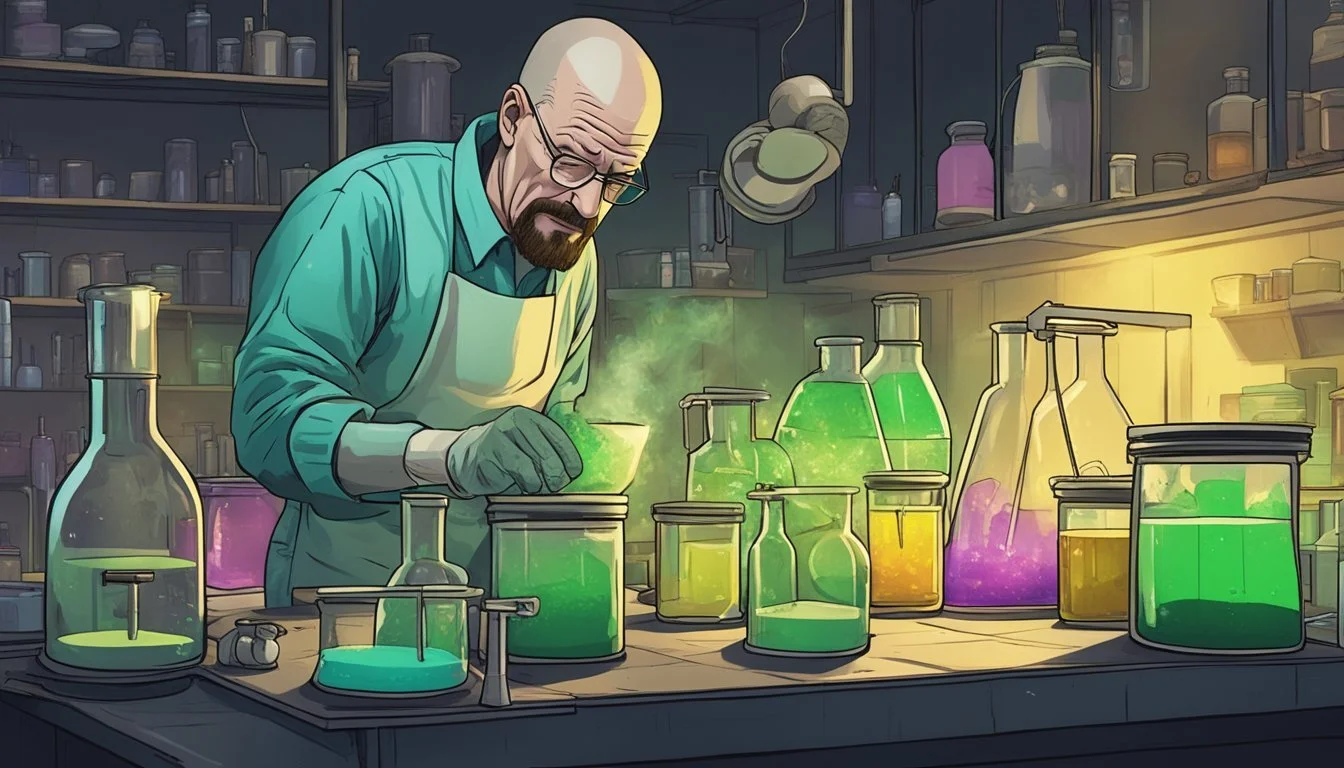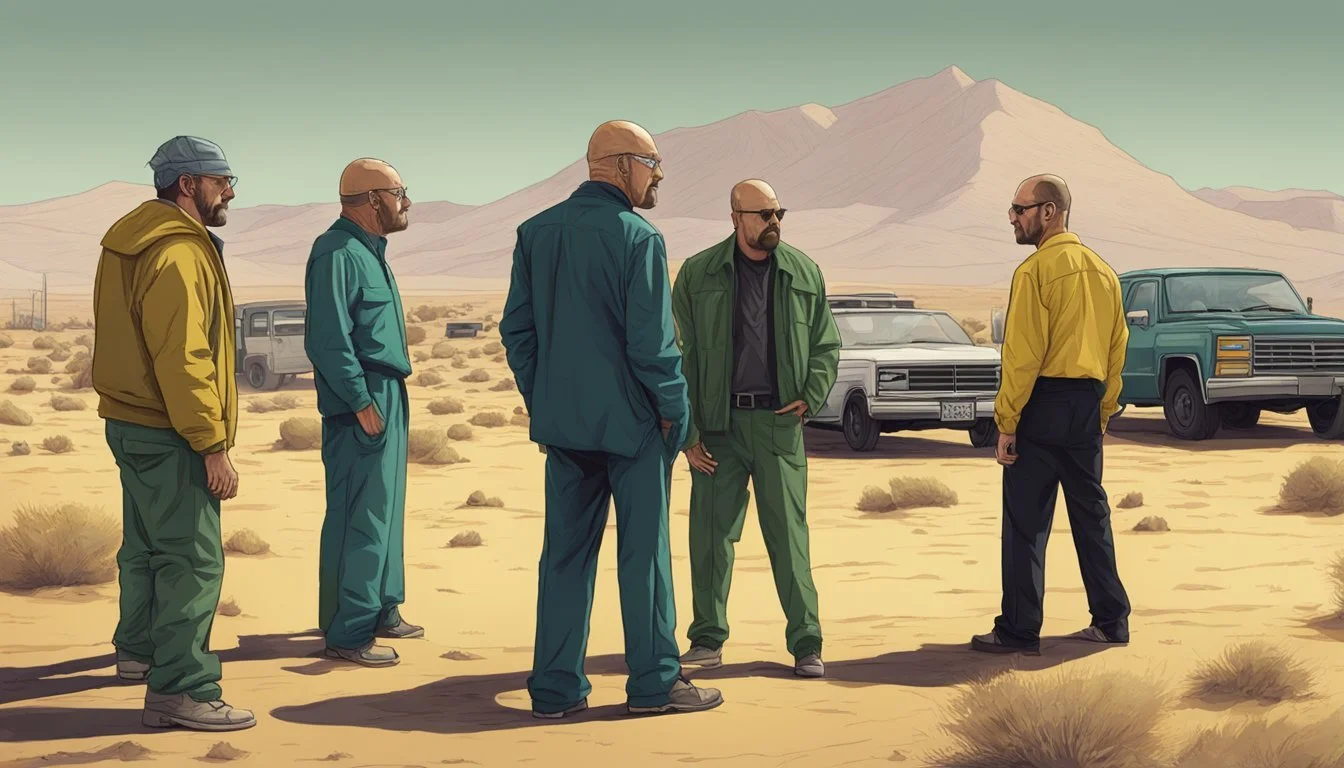12 Breaking Bad Musical Moments That Enhanced the Drama
Unforgettable Scores in TV's Meth Saga
Breaking Bad captivated audiences with its gripping narrative of Walter White's transformation from a mild-mannered chemistry teacher to a ruthless drug kingpin. The show's creators skillfully used music to amplify the drama and tension throughout the series.
The carefully chosen musical selections in Breaking Bad played a crucial role in enhancing pivotal moments and character development. From haunting original scores to well-placed licensed tracks, the show's soundtrack became an integral part of its storytelling. These musical moments heightened emotions, underscored themes, and left lasting impressions on viewers.
1) 'Baby Blue' by Badfinger in the finale
Breaking Bad's final scene features Badfinger's 1972 hit "Baby Blue" playing as Walter White surveys his meth lab for the last time. The song choice perfectly encapsulates the series' themes and Walter's journey.
The opening lyrics, "Guess I got what I deserved," align with Walter's fate after his descent into the drug world. The track's melancholic tone matches the bittersweet conclusion of Walt's story.
Vince Gilligan, the show's creator, selected "Baby Blue" for its lyrical relevance and emotional resonance. The song's title also cleverly references the blue methamphetamine that became Walt's signature product.
The use of "Baby Blue" in the finale garnered significant attention, leading to a resurgence in the song's popularity. After the episode aired, the track experienced a massive spike in digital downloads and streaming.
This musical moment serves as a fitting end to Breaking Bad's five-season run. It exemplifies how the show's creators used music to enhance storytelling and deepen emotional impact throughout the series.
2) Jesse's daydream about 'Crystal Blue Persuasion'
The use of "Crystal Blue Persuasion" by Tommy James and the Shondells in Breaking Bad perfectly captured Jesse Pinkman's mindset. The song played during a pivotal montage in episode 5.08, "Gliding Over All."
Its upbeat tempo and style matched Jesse's energetic personality. At the same time, the track's raw, sinister edge reflected the dangerous spiral of the meth business.
The lyrics about "crystal blue persuasion" took on new meaning in the context of Walter White's signature blue methamphetamine. This clever musical choice emphasized the allure and destructive power of their product.
As the montage unfolded, viewers saw the expansion of Walt and Jesse's meth empire. The dreamy quality of the song mirrored Jesse's initial excitement about their success.
The irony of using this seemingly innocent 1960s pop song to soundtrack illegal activities added another layer of depth to the scene. It highlighted the contrast between Jesse's youthful optimism and the dark reality of their situation.
3) Walt sings 'My Way' in the car
In a memorable scene from Breaking Bad, Walter White sings along to Frank Sinatra's iconic song "My Way" while driving his car. This musical moment occurs after Walt has made significant progress in his transformation from high school chemistry teacher to methamphetamine kingpin.
The choice of song is particularly fitting, as its lyrics about facing life's challenges and making difficult choices mirror Walt's own journey. As he belts out the chorus, viewers can sense Walt's growing confidence and pride in his criminal accomplishments.
This scene effectively uses music to underscore Walt's character development. It showcases his increasing boldness and self-assurance as he embraces his new identity as Heisenberg. The juxtaposition of the upbeat classic with Walt's morally questionable actions creates a complex emotional response in the audience.
By incorporating this well-known song, the show's creators add depth to Walt's characterization. It highlights his belief that he's forging his own path, regardless of societal norms or ethical considerations. The musical interlude provides insight into Walt's mindset without the need for explicit dialogue.
4) Skyler's karaoke night with 'Happy Birthday'
In Breaking Bad's second season, Skyler White delivers an unforgettable musical performance during a company party. The scene takes place at her workplace, where she sings "Happy Birthday" to her boss, Ted Beneke.
Skyler's rendition is a sultry, Marilyn Monroe-inspired version of the classic tune. Her performance creates an awkward atmosphere, highlighting the tension between her and Ted.
This musical moment serves multiple purposes in the show's narrative. It demonstrates Skyler's growing independence from Walt and hints at her complicated relationship with Ted.
The scene has become iconic among Breaking Bad fans. It's often cited as one of the most cringe-worthy moments in the series, eliciting strong reactions from viewers.
Skyler's "Happy Birthday" performance adds depth to her character. It reveals a side of her personality that contrasts with her usual reserved demeanor.
This musical interlude also foreshadows future plot developments. It subtly sets the stage for Skyler's eventual involvement in Ted's business affairs.
5) Gale performing Tom Lehrer's 'The Elements'
Better Call Saul treated viewers to an unexpected musical interlude featuring the character Gale Boetticher. In Season 4, Episode 3, Gale showcased his quirky personality by singing Tom Lehrer's "The Elements" song.
The scene highlighted Gale's enthusiasm for chemistry and his eccentric nature. It provided a lighter moment amidst the show's typically tense atmosphere, offering insight into Gale's character beyond his role in the drug trade.
An extended version of Gale's performance was released as a bonus video. This longer cut gave fans more of David Costabile's impressive rendition, as he sang through the periodic table elements set to a catchy tune.
Tom Lehrer, a renowned satirist and mathematician, originally wrote "The Elements" in 1959. The song's inclusion in Better Call Saul introduced a new generation to Lehrer's clever wordplay and scientific humor.
Gale's musical moment served as a callback for Breaking Bad fans, who remembered the character's brief but impactful role in that series. It also foreshadowed his eventual connection to the world of Walter White and Jesse Pinkman.
6) Marie humming a fateful tune as tension escalates
In one of Breaking Bad's most tense moments, Marie Schrader's seemingly innocuous humming creates an eerie atmosphere. As she tidies up the house, her cheerful tune contrasts sharply with the underlying tension.
The scene occurs during a pivotal point in the series when the truth about Walt's activities is coming to light. Marie's humming serves as an unsettling backdrop to the brewing family conflict.
Her choice of melody, a lighthearted children's song, adds to the discomfort. It highlights Marie's obliviousness to the impending storm and emphasizes the disconnect between appearances and reality.
The musical moment is brief but impactful. It demonstrates how Breaking Bad uses unexpected audio cues to heighten dramatic tension and deepen character portrayals.
Marie's humming becomes a haunting element that lingers in viewers' minds. It exemplifies the show's ability to turn ordinary sounds into powerful narrative tools, enhancing the overall viewing experience.
7) Saul's love for 'Smoke on the Water' ringtone
Saul Goodman's choice of ringtone reflects his flamboyant personality and adds a touch of humor to tense situations in Breaking Bad. The iconic opening riff of Deep Purple's "Smoke on the Water" becomes synonymous with the colorful lawyer's presence.
The ringtone first appears in season 2, episode 8, "Better Call Saul." It interrupts a meeting between Saul and his clients, Walter White and Jesse Pinkman. The familiar guitar notes cut through the tension, providing a brief moment of levity.
Saul's ringtone serves as a clever character-building element. It hints at his love for classic rock and his desire to stand out. The catchy tune also acts as an auditory cue for viewers, signaling Saul's imminent arrival or involvement in a scene.
Throughout the series, the "Smoke on the Water" ringtone becomes a recurring motif. It often sounds at crucial moments, adding a layer of irony or comic relief to serious situations. This musical choice exemplifies the show's ability to blend dark themes with moments of unexpected humor.
8) 'Take My True Love by the Hand' as a haunting background
The Limeliters' folk song 'Take My True Love by the Hand' plays a pivotal role in Breaking Bad's critically acclaimed episode "Ozymandias". As Walter White rolls a barrel of money through the desert, this melancholic tune underscores the gravity of his situation.
The lyrics perfectly capture Walt's predicament. "Times are gettin' hard boys, money's gettin' scarce" resonates with his desperate attempt to salvage his ill-gotten gains. The line "Say goodbye to everyone" foreshadows Walt's impending isolation from his family and former life.
This musical choice creates a stark contrast between the serene melody and the harsh reality of Walt's circumstances. The gentle folk harmonies juxtapose against the barren desert landscape and Walt's physical struggle.
The song's placement in this crucial scene enhances the emotional impact of Walt's downfall. It serves as a poignant reminder of all he has lost in his pursuit of power and wealth. The haunting quality of the music lingers, emphasizing the irreversible nature of Walt's actions.
9) Jane and Jesse bonding over 'She's A Rainbow'
The Rolling Stones' psychedelic hit 'She's A Rainbow' plays a significant role in Jane and Jesse's relationship on Breaking Bad. The song appears during a tender moment between the couple in Jesse's apartment.
As the colorful melody fills the room, Jane and Jesse share a quiet, intimate connection. The lyrics perfectly capture Jane's artistic spirit and the vibrant impact she has on Jesse's life.
The scene showcases their growing bond and mutual understanding. It offers a rare glimpse of happiness and normalcy in Jesse's otherwise chaotic world.
This musical moment stands out as a brief respite from the show's darker themes. It allows viewers to see Jesse in a softer light, emphasizing his vulnerability and capacity for love.
'She's A Rainbow' becomes intrinsically linked to Jane in Jesse's memory. The song's use adds depth to their relationship and heightens the emotional impact of later events in the series.
10) The mariachi ballad about Heisenberg
"Negro y Azul: The Ballad of Heisenberg" stands out as a memorable musical moment in Breaking Bad. This catchy mariachi tune, performed by Los Cuates de Sinaloa, appears in the second season's seventh episode.
The song recounts the growing reputation of Walter White's alter ego, Heisenberg, within the drug trade. Its upbeat melody contrasts sharply with the dark subject matter, creating a unique tonal juxtaposition.
Lyrics detail Heisenberg's rise to infamy and the fear he instills in his rivals. The song serves as both exposition and foreshadowing, highlighting the far-reaching consequences of Walt's actions.
This musical interlude effectively bridges the gap between Walt's local operations and the wider criminal world. It demonstrates how his persona has taken on a life of its own, spreading beyond his control.
The use of a regional Mexican genre adds cultural authenticity to the show's New Mexico setting. It also emphasizes the cross-border nature of the drug trade depicted in the series.
11) 'TNR on My Side' in Hank's last stand
'TNR on My Side' plays a crucial role in one of Breaking Bad's most intense scenes. The song accompanies Hank's final moments in the desert, creating a somber atmosphere that heightens the emotional impact.
As Hank faces his inevitable fate, the music underscores the gravity of the situation. The slow, melancholic tune contrasts sharply with the tense confrontation, emphasizing the tragic nature of Hank's demise.
The choice of this particular song adds depth to the scene. Its lyrics about having "time and reason" on one's side take on an ironic meaning, as Hank runs out of both in his pursuit of justice.
The music enhances the sense of finality and resignation in Hank's last stand. It serves as a poignant backdrop to his unwavering determination and bravery in the face of death.
'TNR on My Side' elevates the dramatic tension of this pivotal moment in Breaking Bad. Its use demonstrates the show's masterful integration of music to amplify emotional resonance and narrative impact.
12) Walter and Junior bonding over 'Eye of the Tiger'
In a lighter moment amidst the show's intense drama, Walter and his son Junior share a brief but memorable bonding experience over the classic song "Eye of the Tiger." This scene provides a rare glimpse of normalcy in Walter's increasingly chaotic life.
The iconic Survivor track plays as Walter drives Junior to school. The father-son duo sing along enthusiastically, showcasing a genuine connection that becomes increasingly rare as the series progresses.
This musical interlude serves as a poignant reminder of Walter's original motivations - providing for his family. It highlights the stark contrast between these fleeting moments of joy and the dark path Walter ultimately chooses.
The upbeat energy of "Eye of the Tiger" temporarily masks the underlying tensions in their relationship. Its lyrics about determination and overcoming obstacles take on an ironic tone given Walter's secret activities.
This scene demonstrates how music can effectively underscore character dynamics and emotional subtext in Breaking Bad. It offers viewers a bittersweet glimpse of what could have been for the White family.
Musical Storytelling Techniques
Breaking Bad masterfully employed music to enhance its dramatic storytelling. The show's composers and music supervisors used carefully crafted scores and song selections to amplify emotions and deepen narrative impact.
Symbolism in Score Composition
The original score for Breaking Bad incorporated symbolic musical elements to reflect character development and plot progression. Composer Dave Porter utilized distinctive instruments and motifs to represent key themes.
For Walter White's transformation, Porter gradually introduced darker tones and more complex arrangements. This mirrored Walt's descent into the criminal underworld.
The infamous "crystal ship" RV had its own musical identity. A metallic, hollow sound evoked its role as a mobile meth lab.
Percussion played a crucial role in building tension. As dangerous situations escalated, drum patterns intensified to heighten viewer anxiety.
Enhancing Tension with Sound
Breaking Bad's sound design worked in tandem with the score to create a palpable sense of unease. Subtle background noises added depth to pivotal scenes.
The show often employed stark silence to emphasize shocking moments. This technique left viewers on edge, anticipating what might come next.
Diegetic sounds from the environment were amplified for dramatic effect. The buzz of fluorescent lights or hum of lab equipment took on ominous undertones.
Carefully selected licensed tracks punctuated key scenes. Songs like "Crystal Blue Persuasion" provided ironic commentary on the characters' actions and motivations.
Character Development Through Music
Breaking Bad's soundtrack masterfully reflected the evolution of its characters, particularly Walter White's descent into darkness. Carefully chosen songs and original score elements mirrored shifting motivations and personalities throughout the series.
Transformational Themes
Walter White's transformation from mild-mannered teacher to ruthless drug kingpin was echoed in the music. Early episodes featured lighter tones and more upbeat tracks. As Walt embraced his Heisenberg persona, the musical landscape grew darker and more intense.
The use of "Crystal Blue Persuasion" by Tommy James and the Shondells during a montage of Walt's expanding meth empire perfectly captured his growing ambition and power. This song choice brilliantly connected the lyrics to Walt's product and his persuasive abilities.
Composer Dave Porter crafted musical cues that subtly shifted alongside Walt's character arc. The themes became more complex and sinister as the series progressed, mirroring Walt's moral decay.
Character Motifs
Each major character in Breaking Bad had distinct musical elements associated with them. These motifs evolved alongside the characters, reflecting their changing circumstances and inner turmoil.
Jesse Pinkman's themes often incorporated elements of hip-hop and electronic music, representing his youth and street connections. As Jesse faced trauma and loss, his musical cues took on more melancholic tones.
Gustavo Fring's presence was often accompanied by tense, minimalist compositions. These stark arrangements emphasized Gus's calculated nature and the constant threat he posed.
Hank Schrader's themes initially featured confident, bold sounds. As he pursued Heisenberg and faced personal struggles, his musical cues became more uncertain and conflicted.








